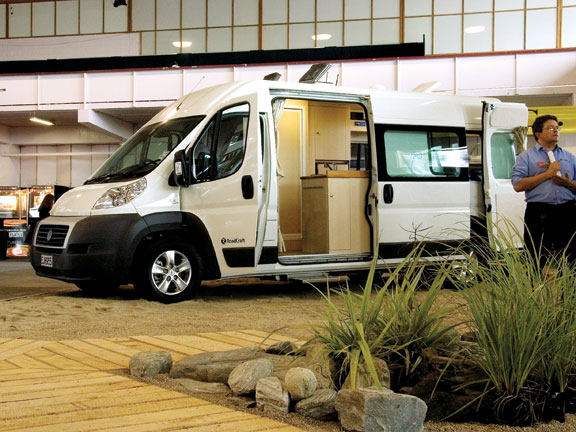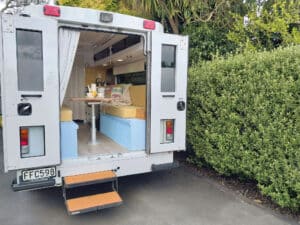As the name implies, the BaseJumper is targeted at those looking for a little more zing in their holiday – people who enjoy skiing, snowboarding, rock climbing, mountain biking, paragliding, fishing – whatever pushes their buttons.
In essence, that means it’s built to handle atypical holiday climates and environments (think snow, ice, cold, wet… rugged terrain) – and get you as close to the action as you dare. So it boasts features such as superior thermal insulation, a diesel heater, a drying room – and a grunty 120hp, turbo-charged diesel engine to take you off the beaten track.
Assembled at RoadCraft’s Auckland factory, the BaseJumper is designed for two and is built on a Fiat Ducato Maxi chassis, a model that’s proved so popular the Italian giant now manufactures it specifically for the international motorhome industry.
It’s a front-wheel drive vehicle, and its power plant – a 2.3-litre, four-cylinder, common rail diesel – delivers its traction through a six-speed manual gearbox. Fully kitted, the motorhome only weighs 3500kg, so you can drive it on a standard car licence. And boasting a much more streamlined body than your typical motorhome (it is, after all, an Italian design), the curvy aerodynamics provide a relatively low drag-coefficient. It’s a lot like driving a large car.
The 120hp engine offers plenty of power for cruising up hills, and the vehicle’s good ground clearance is great for taking you across awkward terrain. ABS braking and large diameter discs all round provide excellent control and stopping power.
As always, fuel efficiency depends on your driving style, but RoadCraft has supplied a number of the vehicles to rental fleets, and says average consumption pans out at around 10kms per litre. It carries a 90-litre fuel tank.
Cab comforts/accessories include dual air bags, a height-adjustable steering wheel, bucket seats, air conditioning, and a CD/radio player with controls on the steering wheel. Unlike most motorhomes, this one doesn’t have the any bodywork extending over the cab or windscreen, so there’s great visibility and a refreshing sense of spaciousness.
Stand-out exterior styling features are the cool set of mag wheels, and large-lens headlights and tail lights that can only be described as works of art. But the piece de resistance (for me) is the subtle graphic adorning the vehicle. It’s an enlarged, topographic map showing contour lines, and more than anything else, hints at the BaseJumper’s adventure pedigree.
Depending on your preferences, the vehicle’s large boot can carry a range of extreme toys, though you might have to use the (optional) matching trailer for mountain bikes, hot-air balloons and kayaks.
Climate Control
Given its target market, the BaseJumper’s designed to venture into climates lesser-spirited travellers might choose to avoid. Consider skiers/snow-boarders, for example.
While it’s suitability for icy terrain sees snow chains supplied as a standard item, the real proof is in the interior insulation. The steel shell is lined with three layers – polyurethane foam, plywood and carpeting. It makes for a very cosy, snug interior, free of condensation.
If it gets really cold, the cocoon can be heated by a 2.2kW diesel-burning Eberspächer (fed from the main tank). Best of all, the bathroom converts to a drying room. It’s purpose-made for wet ski-gear, with heated towel rails (also courtesy of the Eberspächer), so you’ll step into dry kit the next morning.
Interior
Built for two, it’s a compact but well thought-out, functional layout with easy-to-clean surfaces. The U-shaped settee and dining table at the rear of the vehicle converts to a queen bed (1900 x 1500mm). Standard lockers with plenty of usable storage lie under the squabs.
Solid macrocarpa is used for galley surfaces, and the timber’s honey tones present a sense of warmth. Kitchen equipment includes a four-burner Spinflow gas cooker and grill, an 80-litre 12v Engel fridge (with freezer compartment), a sink (with hot/cold mixer) and drawers and lockers stocked with a full complement of pots, pans, crockery and cutlery. Hot water’s supplied by a 14-litre Truma gas heater (it also operates on 240v).
Two water tanks (91 litres each) are built in under the floor (keeps the centre of gravity down low). One is fresh water, the other is for grey water. Both are connected to easy-to-monitor level gauges. If you’re not fussed about modesty, you could also use the outside shower.
Given the remote terrain BaseJumper owners are likely to find themselves in, the electrically-powered fridge is a smart move – there’s not as much of a premium on finding a perfectly level site (as with gas fridges). And if you do have accessories requiring 240v AC (mobile phone chargers, cameras, laptops), on-board power is supplied by a 600-watt inverter. The inverter also allows you to carry a microwave oven.
The vehicle’s fitted with two 220 amp-hour, deep-cycle, 6v house batteries (making 12v) and a conventional 12v start battery for the engine. In addition to the array of halogen lights used throughout the living area, the batteries drive the Majestic home theater system (with its 15” LCD screen) and a CD/DVD/MP3/MP4 player and radio.
There is also an iPod auxiliary socket – and I really like the DVD player’s SD card input. This takes the card from your camera, so (with a robust merlot in hand) you can review the day’s wild activities on the LCD screen.
For the security conscious, a small, lockable safe is built into one of the lockers. It’s bolted and glued into position.
The vehicle comes with a three-year structural warranty on the fit out, and a one-year warranty on the appliances. Fiat offers a three-year/200,000km warranty on chassis and engine.
A perfect companion for the adventurous, the BaseJumper will encourage you to give your imagination free rein – in the nicest possible way. As RoadCraft’s marketing manager Paul Cook says: wild at heart doesn’t mean you have to live in a cave.

Review: 2025 HYMER ML-T 570 CrossOver
Built for those who love the road less travelled, the HYMER ML-T 570 CrossOver combines serious off-road capability with premium European design












